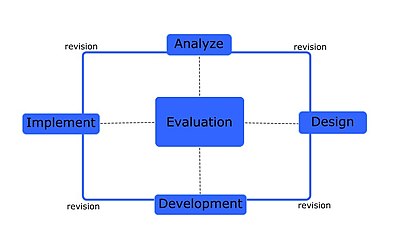Methods and approaches
| Learning and Teaching in Practice | |
|---|---|
| Module 3: Teaching context and learning design | |
| Educational design | Introduction | What is educational design? | The rationale | Learning design roles | Methods and approaches | Summary |
Because educational design is a complex process, it's important to consider the design methods and approaches we use. Various design models have been developed to guide the design process by describing the methods and approaches to be used. The choice of model will depend on several factors, including the teacher's experience and understanding of the design process, the context, and the scope and complexity of the project.
Teaching context
The context in which learning and teaching will take place has significant implications for designing learning activities and resources. For example, in a face to face setting, we may have a class of 15 or 150. We may teach in a 'traditional' lecture theatre, in a laboratory filled with science equipment, or in a computer lab. Or we may be working in a blended learning or fully online context.
These and many other factors will influence the types of activities and resources we use and the ways in which we use them.
There may also be resource constraints - for example, it might be desirable to incorporate a simulation activity but this might require many hours of development time to create.
As teachers, our personal beliefs about teaching and learning (ie an orientation as per Unit 2) affect they way we teach. For example, one teacher may ascribe to a behaviourist theory of learning and another to a social constructivist theory, and they are likely to design very different learning resources and activities:
- A behaviourist orientation is likely to emphasise individual learning, structured in small chunks with regular activities such as multiple-choice testing to measure progress and provide feedback.
- A social constructivist orientation is likely to emphasise group discussion and interaction, sharing of prior learning and inquiry-based projects.
Of course, these beliefs may or may not be made explicit - indeed, it has been said that 'by default, new teachers teach the way they were taught'. This can be especially so in tertiary setting where there is no significant pre-service profession development in 'how to teach'. And in a different context (including with a new generation of learners!) the way we were taught may be no longer appropriate.
Design models
- ADDIE
- A structured, 'top-down' model. Analysis, Design, Development, Implementation, and Evaluation. It focuses on a strong initial Analysis phase where needs are identified and the Design phase includes developing learning objective / outcomes - as such, a formal use of this model may be more suited to curriculum design. However, teachers may find a less formal approach very useful in designing learning activities and resources. In fact, most teachers who plan effectively use some aspect of the ADDIE model, perhaps unconsciously.
Analysis, Design, Develop, Implement, and Evaluate for designing great learner-centred courses using blended learning tools requires several stages:
- A - an analysis of your learners and their context, and other stakeholder requirements;
- D - an overview of the design (or re-design) linking learning outcomes with content, interactions, activities and assessments (pedagogy), and selecting appropriate technologies (technology);
- D - planning the development of learning resources (content), activities, interactions and assessments;
- I - setting out an implementation plan, taking into account resources (including personnel), timelines and milestones.
- E - An evaluation plan to ascertain the effectiveness of your design.
|
- For more information about the place of evaluation in the ADDIE model, check out Using the ADDIE model for effective pedagogical interventions.
- OTARA
- During the Design and Development phases, you may find OTARA: An elearning design learning design framework framework helpful. OTARA is an activity-centred design model and even though it was created specifically to scaffold design for eLearning, it is relevant for any type of course design.
- Gagné's model
- Designing Instruction: A process involving 9 stages - like ADDIE, a top-down model.
- Rapid prototyping
- This model has been used as an approach to software development but can also be used for some aspects of learning design. Focuses on an iterative process of planning, implementing, testing and review. Linked to Kolb's cycle as well as similar models such as PDSA.
- Rapid prototyping models are not normally appropriate suitable for 'big-picture' course design in most contexts but can be very useful as an approach to developing effective teaching and learning.
- Descriptive models
- Rather than spelling out the stages of the learning design process, some models specify the sorts of things that must be considered and included in a learning design document.
- Some examples:
-
- The ARIA Model of Teaching and Learning identifies four key components: Activities, Resources, Interactions, and Assessment.
- The Nga Kiwai Kete model identifies 6 components: Outcomes, Assessment, Learners, Activities, Resources, Guidance.
|
For further information on design models, you might like to check out:
|
|
